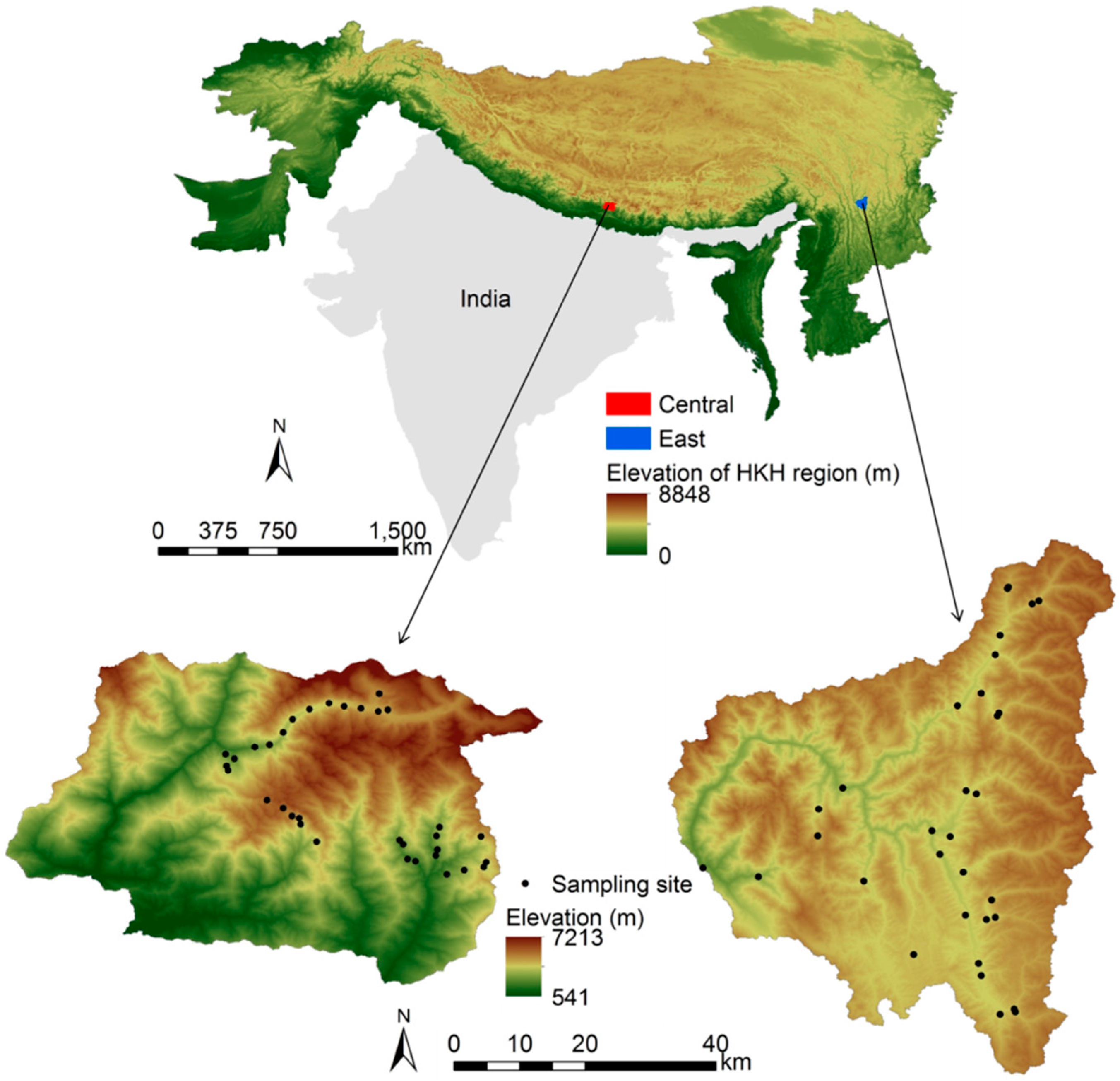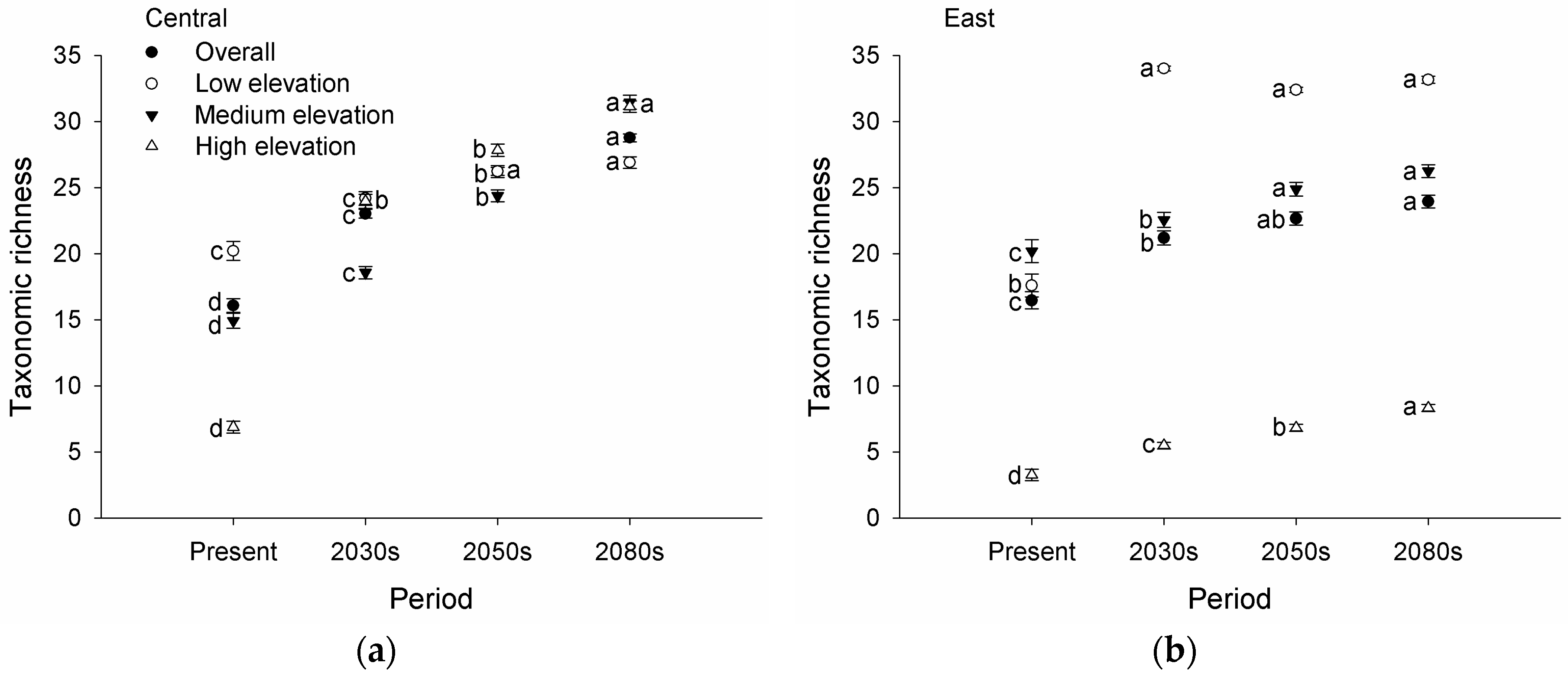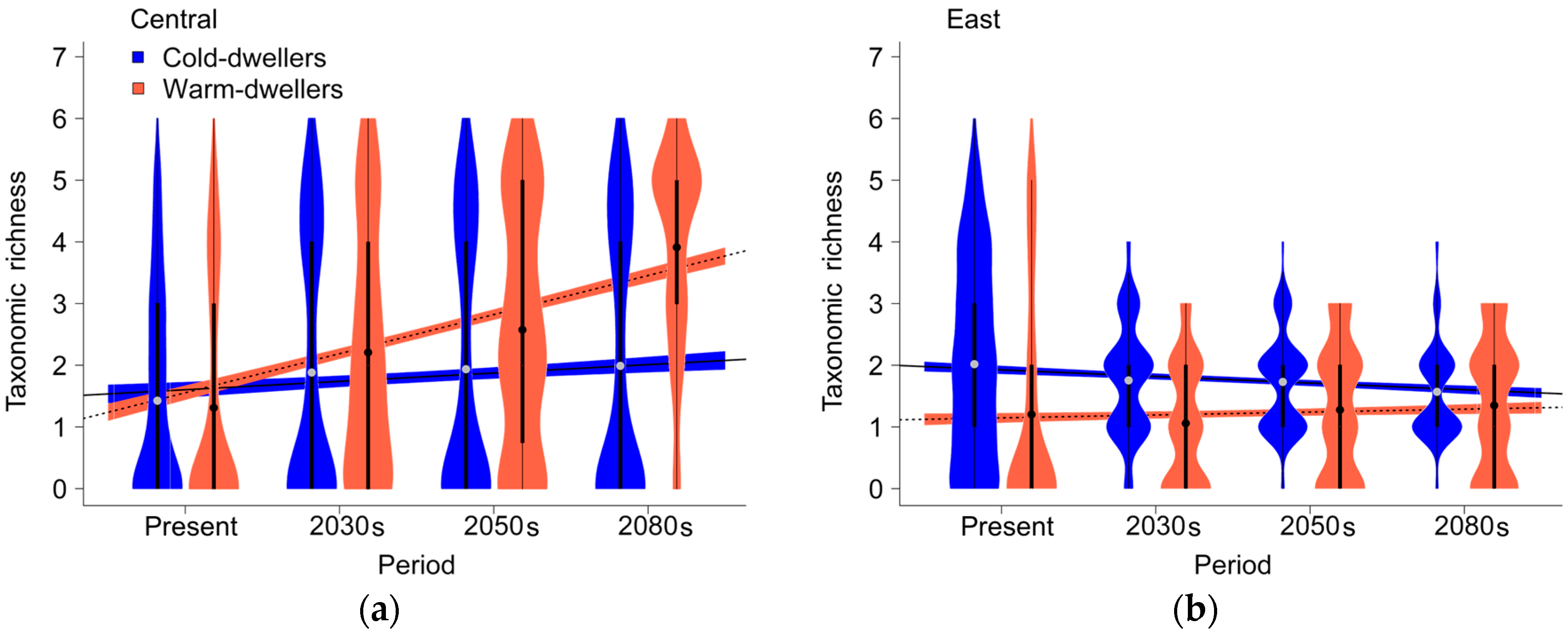Elevational Shifts of Freshwater Communities Cannot Catch up Climate Warming in the Himalaya
Abstract
:1. Introduction
2. Materials and Methods
2.1. Study Region and Data Collection
2.2. Species Distribution Model
2.3. Species Temperature Preference Index and Community Temperature Index
3. Results
4. Discussion
5. Conclusions
Supplementary Materials
Acknowledgments
Author Contributions
Conflicts of Interest
Abbreviations
| SDM | Species Distribution Modeling |
| CTI | Community Temperature Index |
| HKH | Hindu Kush Himalayan Region |
| CCCMA | Canadian Centre for Climate Modelling and Analysis |
| RCP | Representative Concentration Pathway |
| ANN | Artificial Neural Network |
| CTA | Classification Tree Analysis |
| FDA | Flexible Discriminant Analysis |
| GBM | General Boosting Model |
| GLM | Generalized Linear Model |
| MAXENT | Maximum Entropy |
| MARS | Multiple Adaptive Regression Splines |
| RF | Random Forest |
| ANOVA | Analysis Of Variance |
| STPI | Species Temperature Preference Index |
| AAAT | Annual Average Air Temperature |
| TSS | True Skill Statistic |
References
- Parmesan, C.; Yohe, G. A globally coherent fingerprint of climate change impacts across natural systems. Nature 2003, 421, 37–43. [Google Scholar] [CrossRef] [PubMed]
- Wilson, R.J.; Gutiérrez, D.; Gutiérrez, J.; Monserrat, V.J. An elevational shift in butterfly species richness and composition accompanying recent climate change. Glob. Chang. Biol. 2007, 13, 1873–1887. [Google Scholar] [CrossRef]
- Thomas, C.D.; Lennon, J.J. Birds extend their ranges northwards. Nature 1999, 399, 213. [Google Scholar] [CrossRef]
- Chen, I.-C.; Hill, J.K.; Ohlemüller, R.; Roy, D.B.; Thomas, C.D. Rapid range shifts of species associated with high levels of climate warming. Science 2011, 333, 1024–1026. [Google Scholar] [CrossRef] [PubMed]
- De Frenne, P.; Rodriguez-Sanchez, F.; Coomes, D.A.; Baeten, L.; Verstraeten, G.; Vellend, M.; Bernhardt-Romermann, M.; Brown, C.D.; Brunet, J.; Cornelis, J.; et al. Microclimate moderates plant responses to macroclimate warming. Proc. Natl. Acad. Sci. USA 2013, 110, 18561–18565. [Google Scholar] [CrossRef] [PubMed]
- Sheldon, K.S.; Yang, S.; Tewksbury, J.J. Climate change and community disassembly: Impacts of warming on tropical and temperate montane community structure. Ecol. Lett. 2011, 14, 1191–1200. [Google Scholar] [CrossRef] [PubMed]
- Mair, L.; Thomas, C.D.; Anderson, B.J.; Fox, R.; Botham, M.; Hill, J.K. Temporal variation in responses of species to four decades of climate warming. Glob. Chang. Biol. 2012, 18, 2439–2447. [Google Scholar] [CrossRef]
- Devictor, V.; Swaay, C.V.; Brereton, T.; Brotons, L.; Chamberlain, D.; Heliölä, J.; Herrando, S.; Julliard, R.; Kuussaari, M.; Lindström, Å.; et al. Differences in the climatic debts of birds and butterflies at a continental scale. Nat. Clim. Chang. 2012, 2, 121–124. [Google Scholar] [CrossRef]
- Devictor, V.; Julliard, R.; Couvet, D.; Jiguet, F. Birds are tracking climate warming, but not fast enough. Proc. R. Soc. B-Biol. Sci. 2008, 275, 2743–2748. [Google Scholar] [CrossRef] [PubMed]
- Roth, T.; Plattner, M.; Amrhein, V. Plants, birds and butterflies: Short-term responses of species communities to climate warming vary by taxon and with altitude. PLoS ONE 2014, 9, e82490. [Google Scholar] [CrossRef] [PubMed]
- Bertrand, R.; Lenoir, J.; Piedallu, C.; Riofrio-Dillon, G.; de Ruffray, P.; Vidal, C.; Pierrat, J.C.; Gegout, J.C. Changes in plant community composition lag behind climate warming in lowland forests. Nature 2011, 479, 517–520. [Google Scholar] [CrossRef] [PubMed]
- Körner, C. The use of “altitude” in ecological research. Trends Ecol. Evol. 2007, 22, 569–574. [Google Scholar] [CrossRef] [PubMed]
- Gibson-Reinemer, D.K.; Sheldon, K.S.; Rahel, F.J. Climate change creates rapid species turnover in montane communities. Ecol. Evol. 2015, 5, 2340–2347. [Google Scholar] [CrossRef] [PubMed]
- Mason, T.H.; Stephens, P.A.; Apollonio, M.; Willis, S.G. Predicting potential responses to future climate in an alpine ungulate: Interspecific interactions exceed climate effects. Glob. Chang. Biol. 2014, 20, 3872–3882. [Google Scholar] [CrossRef] [PubMed] [Green Version]
- Shrestha, U.B.; Gautam, S.; Bawa, K.S. Widespread climate change in the Himalayas and associated changes in local ecosystems. PLoS ONE 2012, 7, e36741. [Google Scholar] [CrossRef] [PubMed]
- Xu, J.; Grumbine, R.E. Building ecosystem resilience for climate change adaptation in the Asian highlands. Wiley Interdiscip. Rev. Clim. Chang. 2014, 5, 709–718. [Google Scholar] [CrossRef]
- Xu, J.; Grumbine, R.E.; Shrestha, A.; Eriksson, M.; Yang, X.; Wang, Y.U.N.; Wilkes, A. The melting Himalayas: Cascading effects of climate change on water, biodiversity, and livelihoods. Conserv. Biol. 2009, 23, 520–530. [Google Scholar] [CrossRef] [PubMed]
- Telwala, Y.; Brook, B.W.; Manish, K.; Pandit, M.K. Climate-induced elevational range shifts and increase in plant species richness in a Himalayan biodiversity epicentre. PLoS ONE 2013, 8, e57103. [Google Scholar] [CrossRef] [PubMed]
- Brandt, J.S.; Haynes, M.A.; Kuemmerle, T.; Waller, D.M.; Radeloff, V.C. Regime shift on the roof of the world: Alpine meadows converting to shrublands in the southern Himalayas. Biol. Conserv. 2013, 158, 116–127. [Google Scholar] [CrossRef]
- Shah, R.D.T.; Narayan Shah, D.; Domisch, S. Range shifts of a relict Himalayan dragonfly in the Hindu Kush Himalayan region under climate change scenarios. Int. J. Odonatol. 2012, 15, 209–222. [Google Scholar] [CrossRef]
- Li, F.; Kwon, Y.S.; Bae, M.J.; Chung, N.; Kwon, T.S.; Park, Y.S. Potential impacts of global warming on the diversity and distribution of stream insects in South Korea. Conserv. Biol. 2014, 28, 498–508. [Google Scholar] [CrossRef] [PubMed]
- Shah, R.D.T.; Sharma, S.; Haase, P.; Jähnig, S.C.; Pauls, S.U. The climate sensitive zone along an altitudinal gradient in central Himalayan rivers: A useful concept to monitor climate change impacts in mountain regions. Clim. Chang. 2015, 132, 265–278. [Google Scholar] [CrossRef]
- Domisch, S.; JÄHnig, S.C.; Haase, P. Climate-change winners and losers: Stream macroinvertebrates of a submontane region in Central Europe. Freshw. Biol. 2011, 56, 2009–2020. [Google Scholar] [CrossRef]
- Thuiller, W.; Pironon, S.; Psomas, A.; Barbet-Massin, M.; Jiguet, F.; Lavergne, S.; Pearman, P.B.; Renaud, J.; Zupan, L.; Zimmermann, N.E. The European functional tree of bird life in the face of global change. Nat. Commun. 2014, 5, 3118. [Google Scholar] [CrossRef] [PubMed]
- Simaika, J.P.; Samways, M.J.; Kipping, J.; Suhling, F.; Dijkstra, K.-D.B.; Clausnitzer, V.; Boudot, J.-P.; Domisch, S. Continental-scale conservation prioritization of African dragonflies. Biol. Conserv. 2013, 157, 245–254. [Google Scholar] [CrossRef]
- Li, F.; de Figueroa, J.M.T.; Lek, S.; Park, Y.S. Continental drift and climate change drive instability in insect assemblages. Sci. Rep. 2015, 5, 11343. [Google Scholar] [CrossRef] [PubMed]
- Shah, D.N.; Domisch, S.; Pauls, S.U.; Haase, P.; Jähnig, S.C. Current and future latitudinal gradients in stream macroinvertebrate richness across North America. Freshw. Sci. 2014, 33, 1136–1147. [Google Scholar] [CrossRef]
- Shrestha, U.B.; Bawa, K.S. Impact of climate change on potential distribution of Chinese caterpillar fungus (Ophiocordyceps sinensis) in Nepal Himalaya. PLoS ONE 2014, 9, e106405. [Google Scholar] [CrossRef] [PubMed]
- Gajurel, J.P.; Werth, S.; Shrestha, K.K.; Scheidegger, C. Species distribution modeling of Taxus wallichiana (Himalayan Yew) in Nepal Himalaya. Asian J. Conserv. Biol. 2014, 3, 127–134. [Google Scholar]
- Qu, X.; Zhang, Y.; Wu, N.; Tang, T.; Cai, Q. Effects of anthropogenic disturbance on the spatial distribution of macroinvertebrate communities in the Gangqu River of Shangrila. Res. Environ. Sci. 2010, 23, 304–311. [Google Scholar]
- Molinos, J.G.; Halpern, B.S.; Schoeman, D.S.; Brown, C.J.; Kiessling, W.; Moore, P.J.; Pandolfi, J.M.; Poloczanska, E.S.; Richardson, A.J.; Burrows, M.T. Climate velocity and the future global redistribution of marine biodiversity. Nat. Clim. Chang. 2015. [Google Scholar] [CrossRef]
- Thuiller, W.; Georges, D.; Engler, R. Ensemble Platform for Species Distribution Modeling. R Package Version 3.1-64. Available online: https://cran.r-project.org/web/packages/biomod2 (accessed on 23 March 2015).
- R Core Team. R: A Language and Environment for Statistical Computing. R Foundation for Statistical Computing: Vienna, Austria. Available online: http://www.R-project.org (accessed on 24 November 2014).
- Allouche, O.; Tsoar, A.; Kadmon, R. Assessing the accuracy of species distribution models: Prevalence, kappa and the true skill statistic (TSS). J. Appl. Ecol. 2006, 43, 1223–1232. [Google Scholar] [CrossRef]
- Araújo, M.B.; New, M. Ensemble forecasting of species distributions. Trends Ecol. Evol. 2007, 22, 42–47. [Google Scholar] [CrossRef] [PubMed]
- Nenzén, H.K.; Araújo, M.B. Choice of threshold alters projections of species range shifts under climate change. Ecol. Model. 2011, 222, 3346–3354. [Google Scholar] [CrossRef]
- Pebesma, E.; Bivand, R.; Rowlingson, B.; Gomez-Rubio, V.; Hijmans, R.; Sumner, M.; MacQueen, D.; Lemon, J.; O’Brien, J. sp: Classes and Methods for Spatial Data. R Package Version 1.2-1. Available online: https://cran.r-project.org/web/packages/sp (accessed on 20 February 2015).
- Caissie, D. The thermal regime of rivers: A review. Freshw. Biol. 2006, 51, 1389–1406. [Google Scholar] [CrossRef]
- Walther, G.-R.; Beißner, S.; Burga, C.A. Trends in the upward shift of alpine plants. J. Veg. Sci. 2005, 16, 541–548. [Google Scholar] [CrossRef]
- Bässler, C.; Hothorn, T.; Brandl, R.; Müller, J. Insects overshoot the expected upslope shift caused by climate warming. PLoS ONE 2013, 8, e65842. [Google Scholar] [CrossRef] [PubMed]
- Sauer, J.; Domisch, S.; Nowak, C.; Haase, P. Low mountain ranges: Summit traps for montane freshwater species under climate change. Biodivers. Conserv. 2011, 20, 3133–3146. [Google Scholar] [CrossRef]
- Bálint, M.; Domisch, S.; Engelhardt, C.H.M.; Haase, P.; Lehrian, S.; Sauer, J.; Theissinger, K.; Pauls, S.U.; Nowak, C. Cryptic biodiversity loss linked to global climate change. Nat. Clim. Chang. 2011, 1, 313–318. [Google Scholar] [CrossRef]
- Campbell Grant, E.H.; Lowe, W.H.; Fagan, W.F. Living in the branches: Population dynamics and ecological processes in dendritic networks. Ecol. Lett. 2007, 10, 165–175. [Google Scholar] [CrossRef] [PubMed]
- Grabherr, G.; Gottfried, M.; Pauli, H. Climate effects on mountain plants. Nature 1994, 369, 448. [Google Scholar] [CrossRef] [PubMed]
- La Sorte, F.A.; Jetz, W. Projected range contractions of montane biodiversity under global warming. Proc. R. Soc. B-Biol. Sci. 2010, 277, 3401–3410. [Google Scholar] [CrossRef] [PubMed]
- Estrada, A.; Meireles, C.; Morales-Castilla, I.; Poschlod, P.; Vieites, D.; Araújo, M.B.; Early, R. Species’ intrinsic traits inform their range limitations and vulnerability under environmental change. Glob. Ecol. Biogeogr. 2015, 24, 849–858. [Google Scholar] [CrossRef]
- Parmesan, C. Ecological and evolutionary responses to recent climate change. Ann. Rev. Ecol. Evol. Syst. 2006, 37, 637–669. [Google Scholar] [CrossRef]
- VanDerWal, J.; Murphy, H.T.; Kutt, A.S.; Perkins, G.C.; Bateman, B.L.; Perry, J.J.; Reside, A.E. Focus on poleward shifts in species’ distribution underestimates the fingerprint of climate change. Nat. Clim. Chang. 2013, 3, 239–243. [Google Scholar] [CrossRef]




| Region | Range | Number of Samples | Elevation (Mean ± SD) | Slope | Intercept | ANOVA | ||
|---|---|---|---|---|---|---|---|---|
| df | F | p | ||||||
| Central | Overall | 500 | 2902 (±1186) | 1.59 | 17.17 | 3, 1996 | 221 | <0.0001 |
| <3000 m | 286 | 2002 (±509) | 0.85 | 20.99 | 3, 1140 | 31 | <0.0001 | |
| 3000–4000 m | 98 | 3531 (±321) | 2.12 | 13.86 | 3, 388 | 202 | <0.0001 | |
| >4000 m | 116 | 4590 (±390) | 2.96 | 10.62 | 3, 460 | 534 | <0.0001 | |
| East | Overall | 500 | 3490 (±573) | 0.91 | 17.42 | 3, 1996 | 36 | <0.0001 |
| <3000 m | 85 | 2557 (±307) | 1.79 | 22.15 | 3, 336 | 276 | <0.0001 | |
| 3000–4000 m | 318 | 3508 (±270) | 0.79 | 20.36 | 3, 1268 | 18 | <0.0001 | |
| >4000 m | 97 | 4249 (±172) | 0.63 | 3.47 | 3, 384 | 47 | <0.0001 | |
© 2016 by the authors; licensee MDPI, Basel, Switzerland. This article is an open access article distributed under the terms and conditions of the Creative Commons Attribution (CC-BY) license (http://creativecommons.org/licenses/by/4.0/).
Share and Cite
Li, F.; Shah, D.N.; Pauls, S.U.; Qu, X.; Cai, Q.; Tachamo Shah, R.D. Elevational Shifts of Freshwater Communities Cannot Catch up Climate Warming in the Himalaya. Water 2016, 8, 327. https://doi.org/10.3390/w8080327
Li F, Shah DN, Pauls SU, Qu X, Cai Q, Tachamo Shah RD. Elevational Shifts of Freshwater Communities Cannot Catch up Climate Warming in the Himalaya. Water. 2016; 8(8):327. https://doi.org/10.3390/w8080327
Chicago/Turabian StyleLi, Fengqing, Deep Narayan Shah, Steffen U. Pauls, Xiaodong Qu, Qinghua Cai, and Ram Devi Tachamo Shah. 2016. "Elevational Shifts of Freshwater Communities Cannot Catch up Climate Warming in the Himalaya" Water 8, no. 8: 327. https://doi.org/10.3390/w8080327
APA StyleLi, F., Shah, D. N., Pauls, S. U., Qu, X., Cai, Q., & Tachamo Shah, R. D. (2016). Elevational Shifts of Freshwater Communities Cannot Catch up Climate Warming in the Himalaya. Water, 8(8), 327. https://doi.org/10.3390/w8080327






